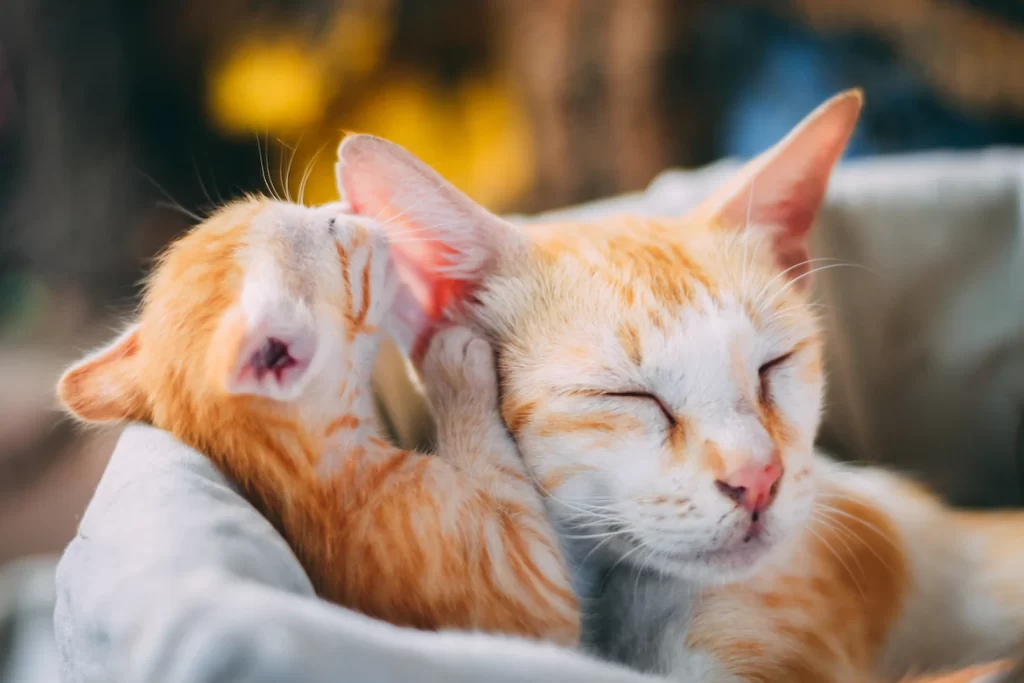Last updated on February 12th, 2023 at 01:55 am

Cats are stunning animals to keep as pets. Their display of grace and neatness makes them popular among pet owners. However, there are numerous questions regarding the pregnancy and delivery of cats. Queening is the process by which a cat gives birth. Most cats give birth in the same way that humans do: they deliver kittens, including the placenta and umbilical cord, through the birth canal and out the vagina, and they nurse and care for their kittens after delivery. However, where do cats give birth?
An indoor mother cat may frequently relocate her kittens to a closet, beneath a bed, a dresser drawer, behind a sofa, or even a kitchen cabinet. She may also decide that the location has become her domain and defend it ferociously, even against her masters, once there. There is a lot of information you need to know about cats that give birth, and we are here to provide it to you.
Where Do Cats Give Birth?
When they are ill, uncomfortable, or even just in a bad mood, cats have a strong preference for being alone, which is one of their defining characteristics. It is not acceptable for this behavior to change in any way during either the pregnancy itself or the time leading up to the delivery.
As common knowledge, childbirth is an extremely unpleasant experience for both the mother and the baby in lower animals, as well as for humans. As was mentioned earlier, when they are in pain, cats prefer to be left alone since it helps them feel better. Because they are animals, it is possible that one may believe that they would not mind giving birth in front of a large number of people.
After all, other animals do not mind when they give birth in public. In the same way that they exhibit uniqueness in other areas such as their gaits or the degree to which they are selective, they also demonstrate uniqueness in this domain.
They avoid being around other people as much as possible because of the discomfort they experience during the process of giving birth to their young.
When a person is the owner of a cat, that person is the only one who can find out where the cat is giving birth. There is no other way.
Most people who own cats will create quiet, dark places in their homes for their pets to give birth in. When a location is not prepared for them, they go for somewhere isolated and dark to hide. Because it is typically concealed in a location that is inaccessible to both animals and people, this is the location that they choose to use when they are having their young.
The fact that they want to be by themselves during their pregnancies explains their tendency to behave in this manner. In addition, they like their own solitude while they are grooming themselves prior to labor. As a result, they choose dim environments throughout the labor and delivery phase.
What are the Symptoms of a Cat in Labor?
Clear or colored vaginal discharge, severe stomach straining, and the arrival of kittens are all signs of labor in cats. A pregnant cat would most likely seek out and remain in a nesting box where she may safely deliver babies. Cats have three phases of labor and depending on how many kittens are born, labor can last anywhere from 16 hours to 3 days.
How Long Does A Cat Take To Give Birth?
Most cat owners are curious about when their cat became pregnant because these lovely creatures do not even show signs of pregnancy until they are close to giving birth. Typically, the process appears to be quite quick, which it is.
Pregnancy lasts between fifty-seven and sixty-eight days, depending on the cat’s physique. The entire pregnant phase is really brief.
A cat’s birth might take anywhere from two to five hours (s). The length of time spent during birth is determined by the number of kittens to be delivered. Cats can give birth to one to eight kittens at one time. After the labor begins, the cat may take thirty minutes to birth each kitten, pausing in between to push out another kitten.
If the cat only has to give birth to one kitten, the entire process should not take more than three hours. It sometimes relies not only on the number of kittens expected to be born but also on the cat’s body.
Some cats, such as Persians and other flat-faced varieties, are unable to deliver kittens naturally and must undergo Cesarean section surgery to do so. A DVM performs this procedure while under general anesthesia. Normal gestation (the time it takes for a cat to become pregnant) lasts 63-65 days. Mother cats usually know what to do when it is time to deliver, and if you find them making or sleeping in a warm nest, you are in the final week of pregnancy and the birthing process is about to begin.
How Can I Help A Cat Giving Birth For The First Time?
If you have a cat that is giving birth for the first time, you might wish to help it. The method of assisting the delivery process in cats differs from that of humans. When a cat is about to give birth, it is critical to consult with your veterinarian about the best conditions for expectant cats.
Most cats prefer to give birth in the dark, away from light. You don’t have to wait for your cat to select an appropriate location on its own because of this behavior. Because it is pregnant, it requires assistance. This is accomplished by establishing a gloomy environment in which it can feel at ease before its delivery time. This gloomy environment can be produced in a cardboard box or even a basket.
Towels and blankets should be plenty in the area designated for your cat in order to keep the cat and its offspring warm. As the birth date approaches, the cat’s temperature decreases dramatically, which may be harmful to the kittens.
The blankets and towels aid in maintaining body temperature. Towels and pads should be stored in the box in a specific arrangement. The heating pad should be kept in the final layer, extremely close to the cardboard box, to keep the temperature of the entire box warm. Absorbent pads should be kept in the delivery area to keep the cardboard box clean.
Only intervene if a cat is in distress, and then immediately return the kitten. Keep an eye on each shipment. When the mother enters her nesting box and labor begins, the greatest thing you can do is be cool, be prepared, and keep an eye on the delivery.
If the mother has been having active contractions for more than 60 minutes and no kitten has been born, contact the veterinarian immediately. It’s possible that there’s a kitten stuck in the birth canal.
How Can You Tell If A Cat Is Still Carrying Kittens Inside Her Tummy?
There are several ways to tell if a cat has kittens inside it, starting with the weight gain that is unavoidable due to the number of kittens in the cat’s tummy. There’s also the roundness of the kitten-carrying cat’s abdomen.
Whether the cat has already begun to give birth and you want to know if there are any more kittens to be born, you can easily tell by stroking the lower belly, close to the tail; you will feel if there is a kitten left to be born.
It is not always advisable to assist the cat in pushing out the kitten. When it comes time for the kitten to come out, it will do it on its own. As a result, it is best not to agitate your cat by attempting to extract its kitten. If you left your cat alone for a bit, it would bring out its young after some rest.
There are no indications that indicate whether the kittens in the cat’s belly are alive or dead. Even if the kittens are dead or alive, the belly is usually swollen. The procedure is also extremely similar to that of a regular pregnancy in a cat. Even if the kittens are dead within, the nipples will be enlarged and larger. During kitten birth, the dead kittens generally cause dystocia. Due to dead kittens, there is frequently a delay in the delivery time, which may not follow the regular course of kitten birth. This can lead the kittens to become stuck in the delivery canal, causing significant agony to the mother.
Only during the delivery phase can it be determined if a litter is dead in the kitten’s stomach, which turns out to be a major birth issue linked with cat pregnancy. Despite the fact that there are no indicators that a cat is harboring deceased kittens, an abdomen scan can be used to identify if the kittens inside the cat are dead.
The abdomen scan cannot be performed at home; it must be performed by a veterinarian. The scan would reveal the kittens’ health as well as which kittens are living and which are already dead. This is why, if it is discovered that your cat is pregnant, it is a prudent option to take it for periodic tests at the veterinary doctor to ensure the cats’ overall health. These regular exams are also beneficial in determining whether there are any conditions that are harmful to the cat and its pregnancy. Also, seek advice from a veterinarian to ensure that the kittens survive the pregnancy.
Do Cats Prefer Being Left Alone During Pregnancy?
We all know that the labor process is excruciatingly painful. With this in mind, cat owners would give anything to keep their animals pain-free during labor.
However, because this is an extremely stressful time for the cat, she may be offended by constant touch. Cats who are used to having direct touch with their carers on a daily basis may be less aggressive when it comes to giving birth in front of this person.
However, this would not modify its irritability when the handling is excessive or they are just uncomfortable. Even though they are uncomfortable, their attachment to their caregiver does not change the reality that they can give birth on their own without any external assistance.
The caregiver’s presence during delivery may hinder delivery if the person attempts to pick up or touch the kitty. It is best for the owner (caregiver) to see the delivery process from a distance so as not to disrupt or strain it. The answer to the question “Do cats like being alone while giving birth?” is yes, because as sociable creatures, they have solitary behavior during pregnancy. Because of their solitary nature, they would rather have themselves as a company throughout delivery than have anyone approach close to them.
Conclusion
It’s a straightforward procedure that takes place in three stages; while it’s possible that your queen won’t need any assistance when she’s giving birth, it’s important to have the contact information of your local veterinarian on hand just in case. Keep in mind that if this is your first time assisting your cat in giving birth, you should see your veterinarian for assistance and supplies.


